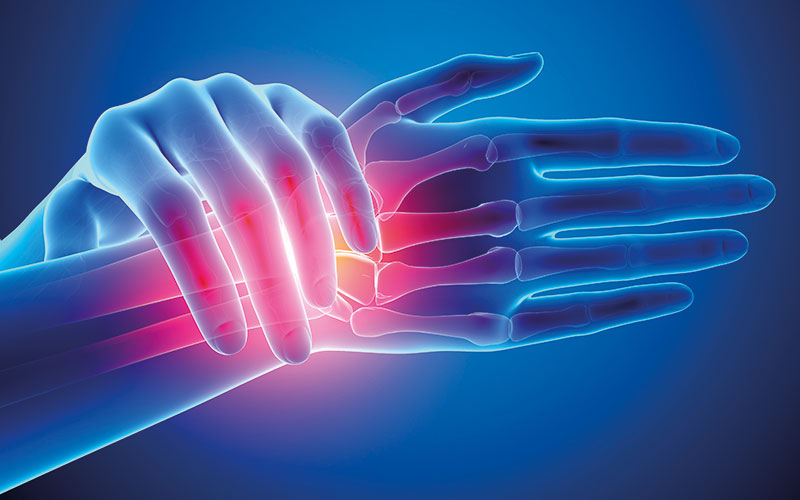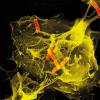Carola Vinuesa explains her research into lupus and what happened when a TLR7 mutation was introduced to mice using CRISPR gene-editing.

The symptoms of lupus, an autoimmune disease that causes the body to attack its own healthy tissue and organs, can manifest in many different ways. This includes aching joints and muscles ,extreme tiredness, skin rashes, anaemia, inflammation and weight gain or loss. The disease rarely affects any two people in the same way – this and the general nature of the symptoms means it can often be mistaken for a whole range of other diseases.
Though lupus was first identified as far back as 1851, its protean nature has meant that its specific cause has yet to be pinpointed. Its onset can happen in adolescence, after childbirth, during the menopause, even after trauma. It is more prevalent in females than males, and it can run in families, suggesting a genetic link. As with any disease where the exact trigger remains uncertain, the treatment is also non-specific, predominantly immunosuppressants and anti-inflammatories to prevent and control flare-ups.
The causes of lupus
All this may have just changed with the publication in Nature of a paper called “TLR7 gain-of-function genetic variation causes human lupus”. As the title suggests, the team of researchers working out of the Centre for Personalised Immunology at the Australian National University believe they have found the DNA mutation in the specific gene that can cause lupus and that overactivity of the encoded receptor represents an important causative pathway even in patients without gene mutations.
The lead author and investigator is Carola Vinuesa, now Royal Society Wolfson Fellow and principal group leader at the Francis Crick Institute. She says the impetus for the research into lupus has been the lack of deep knowledge for autoimmune diseases in general: “We need to better understand the mechanisms of these diseases so that we can develop better treatments, even though many of these diseases are genetically complex, which means that in the majority of patients it will not be a single mutation or a single gene that explains the disease.”
Despite their rarity, finding those single mutations can reveal the mechanisms of a disease. Vinuesa continues: “A good example is Brown and Goldstein who found that rare patients with early onset heart disease and hypercholesterolaemia had mutations in the LDL receptor.
They identified how important the LDL receptor is for cholesterol metabolism, and then a link was made between LDL cholesterol levels and coronary heart disease in the general population. Now most patients with cardiovascular disease, or who are at risk of developing it, benefit from cholesterol-lowering agents, such as statins. Discovering these rare mutations can illuminate the pathway that might be critical for disease development. With this concept in mind, we thought let’s look at the severe end of the spectrum, at patients we think might be enriched in these mutations.”
Elusive mutation
For Vinuesa’s team, the key to finding that elusive mutation was a Spanish girl called Gabriela, who was diagnosed with lupus at the age of seven. “I know a nephrologist at the largest paediatric hospital in Spain,” says Vinuesa, “she selected some of her most severe lupus cases that had the possibility there could be a severe mutation causing the disease, and one of them was Gabriela. Over the years she and her family have been very generous donating blood.”
The samples were shipped to Australia where Vinuesa and her team sequenced the DNA. “One of the types of mutation that make us suspicious that it might cause disease, what we call de novo variants. These are present in the child, but not the parents. So they’re very recent and could be the culprit.” Allied to this, historical research had suggested that increased activity in the TLR7 gene could cause a syndrome in mice that looked like lupus, while other evidence indicated that the gene might also be linked to the disease in humans. “We had to be cautious,” says Vinuesa. “In humans you can never be sure what is a cause, what is a consequence. But this de novo mutation looked suspicious. We thought let’s put it into mice and see if it does something.”
The same TLR7 mutation found in Gabriela was introduced to mice using CRISPR gene-editing. The results were unambiguous. “It caused full-blown lupus-like disease in every mouse, 100% penetrant, meaning it is sufficient to cause disease. And not just any type of lupus, but very much a severe type, including some of the manifestations that Gabriela had, such as low platelets.
The mice had the constellation of manifestations of lupus. With all of that, we were pretty confident that the mutation causes disease.”

CAROLA VINUESA
- 1993: Autónoma University of Madrid, MBChB/MD
- 2000: University of Birmingham, PhD (immunology)
- 2005: Australian National University (ANU), postdoctoral training (immunogenetics)
- 2006: John Curtin School of Medical Research, ANU, group leader
- 2014: Centre for Personalised Immunology, NHMRC Centre of Research Excellence, director
- 2016: China Australia Centre of Personalised Immunology, Shanghai Renji Hospital, director
- 2021: Francis Crick Institute
Further questions
Having established a model to understand the trigger for lupus, the team conducted further experiments to shed more light on the pathogenesis. “TLR7 signalling has been linked with viral RNA, so the speculation was that viral RNA would cause lupus. While that may be the case in some patients, in Gabriela at least we have shown that’s probably not the case. Instead, this mutated receptor is reacting to a very basic component of all nucleic acids, guanosine, binding to it with higher affinity.” The effect of this is to ramp up the sensitivity of the immune cells to the point where they see healthy tissue as a threat and launch an attack.
The work raises further questions. “Is this pathway, as I suspect, relevant to a large proportion of patients with lupus and perhaps with other systemic autoimmune diseases, such as rheumatoid arthritis? Can we then distinguish those patients that will best respond to therapies that target this receptor?”
The good news is that there are existing drugs, developed for other purposes, that can inhibit TLR7. “We have to wait for those trials, see if they really benefit patients. We also have a mouse model we can use for preclinical studies, also looking at inhibitors that might act immediately downstream of TLR7 and which might be more effective in some patients. Then we need to collaborate with clinicians to see if we can find this pathway to be overactive in a broader range of patients with systematic autoimmunity.”
Image credit | Getty | Michael-Bowles




